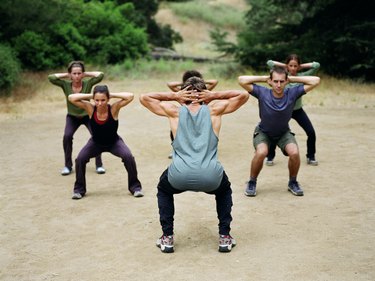
As one of the more popular body-weight exercises you can do, the squat works your abs, butt, hips, calves, shins and thighs, according to the American Council on Exercise. But maybe you're more curious about squats and the calories they burn rather than muscles they work.
The good news is that most experts agree squats are every bit as good for torching calories as they are for building strength. Read on for an explanation of how you can calculate a squat calorie burn, plus more insight into why squats are a great addition to your workout.
Video of the Day
Video of the Day
Tip
The number of calories you burn depends on how quickly you’re doing those 100 squats, as well as on other factors like your weight. Use the formula 5 x 3.5 x your body weight in kilograms / 200 to find the number of calories you are burning per minute on squats.
Read more: Calories Burned During Squats
Squats and Calories
The American Council on Exercise explains that physiologists will determine how many calories an exercise burns based on its metabolic equivalent, frequently called its MET. This number represents how much oxygen the muscle cells in your body are using — using more oxygen means using more energy. More specifically, muscles require about five calories for every liter of oxygen they use.
A body at rest will use approximately 3.5 milliliters of oxygen per kilogram of body weight per minute. If that body is performing an activity that uses twice the oxygen it would require when at rest, then that exercise would have a metabolic equivalent of 2; if the body is using three times as much oxygen, then that activity has a metabolic equivalent of 3, and so forth.
So what about squats and the calories they burn? Resistance training, such as an explosive round of squats, has an MET of 5. For perspective, that's the same as moderate to vigorous yard work, slightly less than moderate lap swimming (MET 5.8) and slightly more than brisk walking (MET 4.3). To determine the number of calories burned, use the following formula:
- MET x 3.5 x body weight in kilograms / 200 = calories per
minute
Therefore, if a 150-pound (68-kilogram) individual did an explosive round of squats, the calories burned would be approximately 5.95 calories per minute. If you're going at a rate of 40 squats a minute — a pretty fast speed — you could do 100 squats in two and a half minutes and burn close to 15 calories.
Benefits of Squats
Squats offer many benefits above and beyond burning calories. According to the Mayo Clinic, body-weight squats and other similar exercises are a great way to get a combined strength and cardio workout. Squats will challenge several muscle groups at once, and they're great for improving your balance and core stability.
The other great aspect of squats is that you can do them at any time and in any place because they require no equipment. That's one of the reasons the U.S. National Library of Medicine suggests doing squats — or push-ups or crunches — every time a commercial comes on TV as a way of breaking up long stretches of being sedentary and as a way of fitting more exercise into your day.
To perform a squat properly, the American Council on Exercise recommends standing with your feet slightly wider than the width of your hips and your toes bent slightly outward. Brace your abs, hold your chest out, tilt your head slightly up and shift your weight to the back of your heels as you move your hips backward and downward.
Lower yourself until your thighs are parallel with the floor. As you rise back up to the starting position, be sure to maintain your back, chest and head position. Ideally, you should inhale on the way down and exhale on your way up.